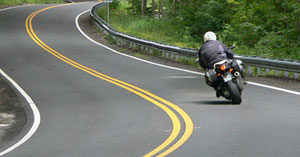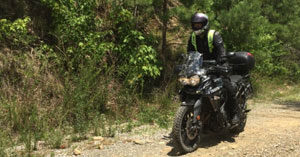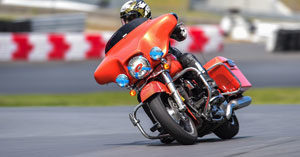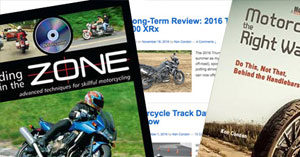Rider Training Options
I will be your personal tour guide and riding coach during these one or two day on-street training tours.
I will show you a good time as we tour the beautiful New England countryside on many of my super-secret twisty roads. While you will certainly enjoy the memories of a great day or weekend ride, but even more importantly, you will gain greater confidence and control.
Unlike parking lot courses, on-street training is done at real world speed and in real world conditions. We will use Sena Bluetooth helmet communicators for real-time coaching while we ride.
Read Testimonials
Read about Ken
Tours are available on weekdays and weekends. Contact me to discuss Private course schedule and payment methods.
The Riding in the Zone, LLC Motorcyclist Training Program is supported by the American Motorcyclist Association and the Massachusetts Rider Education Program (MREP). Scholarships are available through the BMW/MOA Foundation.
![]()
Riding in the Zone, LLC is chartered through the American Motorcyclist Association








Hi Ken
Any schedule for 2020 Berkshire on street training?
I had an excellent coaching ride with Ken recently. We rode through NW MA and SE VT, on some fine twisty country roads. Just what I like. I started riding motorcycles about 40 yeats ago, and now at 68, I am still going strong. Every year I try to find a new learning experience to extend my skills and stay sharp. Ken uses a bluetooth communicator to coach you as he rides behind – observing what you’re doing – and not doing. He really helped me improve my slow speed tight maneuvering. He took videos as we rode and when I watched them at lunch, his feedback that my medium and high-speed turns could be smoother made a lot of sense. During the afternoon, I could really feel the improvement. I would recommend Ken to anyone looking for a good way to advance their skills.
A testimonial from Kathy L.
___
My husband, Tom, and I started riding in 2011. We bought our WeeStroms and then took the MSF training down here in Connecticut. Pretty cocky, eh? We were both in our late 50s then and I knew I would be bored silly riding on the back so I insisted on my own bike from the start. I had never ridden a motorcycle before.
We’ve done over 22,000 miles so far (Nova Scotia, across country, West Virginia, and lots of local riding) but a few particular situations on the road continued to really cause me great anxiety — particularly hairpin turns that are ascending to the right. Argh! I would always end up in the on coming lane, stopped, or worse. So this spring when I saw Ken’s note about day long training, Tom and I decided to sign up. That’s one of the best decisions I’ve ever made.
After our initial talk over breakfast at Elmer’s General Store in beautiful downtown Ashfield, we hit the DPW parking lot. No messing around. Right into those turns. Oy! Ken has so much insight and an amazing range of ways to explain how to do something. I was turning, making the largest S Boxes in history. So, at one point, he said in his gentle but commanding way, “Okay, scoot back and I’ll drive.”
What! He wasted no time as the terror struck. I scooted back, he got on, we rode the smallest, tightest turns I had ever experienced. I was sure we were going to die! But he just kept going around in these beautifully controlled smooth turns with me on the back. I probably didn’t breathe even once. Well, he stopped, got off, and gave me back the controls. I was in shock. I had no idea my motorcycle could turn like that. What an experience!
I can’t say that I immediately could maneuver like a master, but the sensation of moving confidently through a small turn, feeling the energy of the motorcycle, the physics of motion, was a real eye opener. Wow.
We’ve gone back to our own parking lot a couple of times since and I am so improved — more to the left than the right but both are so much better. The day after our lesson, we rode up the north entrance to Mount Greylock and down the south, with the nice little hairpins, and I handled them better than I ever have. Tom made us turn around and do the south road a couple more times. And each time, I felt more control.
During the day long training with Ken, we rode up to Vermont and, through our helmet communicators, he worked with both of us on our technique in many different riding situations. We’ll never ride curves the way we used to. Even though we had the general outside inside outside concept, Ken had a way of giving us an even deeper understanding how to read the road and place ourselves in the best possible position for safety and visibility. Wow.
We’re off to Oregon for a three week gallavant this summer on our bikes. Seeing all the hairpin turns on the maps I feel much more prepared to meet them with safety and confidence thanks to your Dad. Thank you, Ken.
Spending a day (or half a day even) with Ken for a rider at any level will be so valuable. If it’s crossed your mind, do it. You’ll be so glad you did.
A testimonial from J.C.
Our training day started at Elmer’s Store in Ashfield where Joe, the other rider, and I filled out an evaluation that did a good job of helping me determine where my weaknesses were and where to focus. We then talked with Ken about our responses which help Ken set the tone for the day in terms of exercises and the route itself. For me that turned out to be an important process as the route was changed based on that conversation. A route that seemed to be tailor made for the very things I needed to work on.
The first stop was the Ashfield highway department parking lot where we practiced low speed tight turns and emergency braking. I ride a Yamaha Warrior which is not known for its nimbleness but I was able to get the bike to comply pretty well when I followed his instruction to fully twist my head around and up. Almost an epiphany moment.
The next exercise was harder for me. We did emergency braking with a fixed point and also with Ken choosing our moment of reaction. He was very patient and I lost count on how many times I went around to try it again but I did get to a point where my head understood what to do but my reacting muscles were not able to cease from going into a harder lock down than was needed on the back brake. The important lesson from this exercise was the importance of practicing these on a regular basis. Ken did a good job of hammering that home.
After this phase of parking lot work was finished we headed out for the open road part. Some very interesting things came out of this part of the program. Ken noticed very quickly that I was sitting crooked on the saddle. This was subconscious on my part but it was so pronounced he asked me if I had a spinal injury. After assuring him I did not we went about trying to figure out what it was happening. It turned out that the ol’ wallet in the back pocket routine was to blame so I removed the wallet and began the process of making myself sit straight even though it felt odd. Another eureka moment.
As we rode Ken spent more time leading and demonstrating positioning and braking into corners. This allowed me to first try and emulate his moves as I listened to him describe them on the radio. During this time Ken would also talk about what was happening on the sides of the road to expand our sense of awareness about what might happen ON the road as a result of what was going on off the road. Then, taking turns Ken would have Joe or myself take the lead where he would continue the commentary and also capture our activity on the ProCam. The terrain, road conditions, traffic and distractions were all there to provide a good variety of situations that kept us focused.
At that point we broke for lunch and enjoyed superb food and great conversation which included many topics and not just riding which helped us relax and enjoy the break. Back on the road now Ken took us back to a particularly track like set of curves on a recently paved section of a ridge road running along side an industrial wind farm. Nice backdrop! Here we took turns going through these curves with Ken on our heels and with his usual excellent commentary all the while filming our every move.
After that it was a leisurely ride home with little to no comments about what we were doing leaving us free to practice what we had learned without too much distraction. At the end of the ride I was treated to an incredibly in-depth review of the video taken of me during the ride. This was the first time I had an opportunity to see myself on a bike and to do so with Kens experienced insight was an extremely useful and rewarding session. It was indeed the highlight of the day.
I was very impressed with the whole program. Ken is an outstanding instructor and a pleasure to ride with. As an intermittent rider who took motorcycle training when I got back on the bike this experience was way beyond what I received from my prior training and was really necessary to discover and mitigate some of the many bad habits I had acquired over the years. Something that every rider should consider.
J.C.
Hello Ken nice web site and your personel training is something I would enjoy and learn a bunch. I just read your article in MCN about instructors and really agree with it . about me this summer marks my 50th year as a near full time rider I’ve crossed America and Canada a few times and ride as often as I can. I’ve been a MSF instructoe first in 1988 then full time every week in the summer since 1999 in Reno NV. I was wondering if you couls share your ideas on difficult students ,who have great hearts but just won’t follow my coaching ? examples are not ever getting above 8 mph, not holding the handlebars by constantly covering the brake and clutch lever . after repeated coaching about visual directionl control only looking at the ground . often the student denies my observations and remarks their doing the exercise correctly. I could go on but just t a not to see if you have time to respond
Thanks for any assistance and look forwad to more of your articles
Eddie Nolte
MSF lead instructor #02356
Reno NV 775-827-6338
I’m glad you liked the MCN article. As you know, it takes creativity to reach those tough students. It sounds to me as though a key part of learning may be missing, which is to communicate how doing things the way you suggest will make riding easier. Be specific about the benefits and then reinforce this if they seem not to get the concept. Once the concept/benefit is truly realized, then they will be motivated to put your coaching into practice.
Without this meaningful motivation, you are relying on them to simply “Do as I say”. Be sure that you focus on effectively communicating what the student NEEDS, rather than simply telling them what they SHOULD DO. These are 2 different things, sometimes. Yes, we need to follow the curriculum, but the goal is not for a student to do the exercise “right”, rather to follow the curriculum as a guide to help them to build their skills.
An example: If a student is looking down, you may ask them to give you examples in their life where looking ahead helps them to achieve a goal. (playing tennis, skiing, walking around a corner, etc.) New riders often “get it” if they can relate to how riding a motorcycle relates to things they already know.
Think of these problem student as facilitators to expanding your coaching prowess. If they aren’t getting it, pull a different tool out of your box and try it.